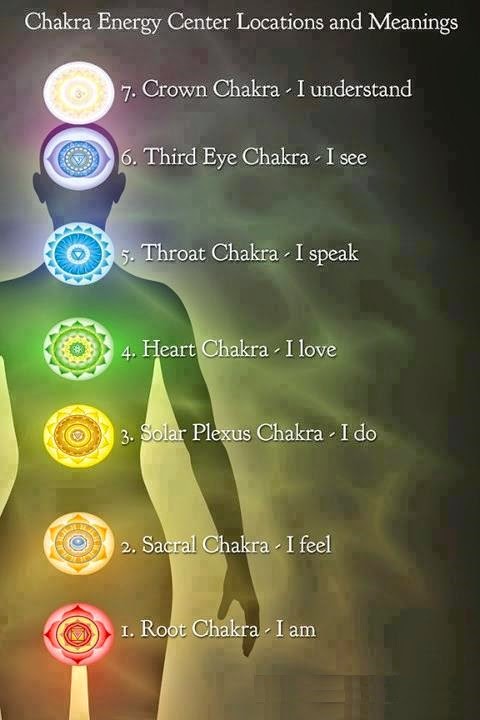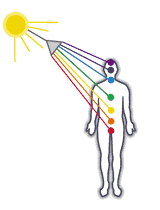Introduction of Chakras
A person can collect energy from several different levels of vibrations–including color–that are utilized in various parts of the body. Throughout our body we have main energy centers, which are connected to major organs or glands that govern other body parts. Each of these main energy centers are referred to as chakra–chakra is a Sanskrit word which means wheel. A chakra is a wheel-like spinning vortex that whirls in a circular motion forming a vacuum in the center that draws in anything it encounters on its particular vibratory level.
It is said that our body contains hundred of chakras that are the key to the operation of our being. These “spinning wheels” draw-in coded information from our surroundings. Coded information can be anything from a color vibration to ultra-violet ray to a radio or micro wave to another person’s aura. In essence our chakras receive the health of our environment, including the people we are in contact with (that’s why other people’s moods have an affect on us!). As well our chakras also radiate an energy of vibration.
It is also believed that we have seven main chakra centers and that each main center is connected to our being on several different levels: physical, emotional, mental and spiritual. On the physical level each chakra governs a main organ or gland, which is then connected to other body parts that resonate the same frequency.
Every organ, gland and body system is connected to a chakra and each chakra is connected to a color vibrational frequency. For example, the heart chakra governs the thymus gland and it is also in charge of the functioning of the heart organ, lungs, bronchia system, lymph glands, secondary circulatory system, immune system as well as the arm and hands. And the heart chakra resonates to the color green.
The seven main chakra centers are aligned along the spinal column. If there are disturbances on any level, this shows in the chakra’s vitality level. Also each of the seven main chakras is their own intelligence center. This means that each chakra is not only associated with our physical health but also controls aspects connected to our emotional, mental and belief system.
To help balance a chakra–whether on an emotional, intellectual, physical or spiritual level–we need to bring in the chakra (color) vibration, which resonates at the same frequency.
In the study of the anatomy of the aura it is important to understand the significance of the chakra system and the language of colors expressed in the aura.
The names of the seven main chakras and the master organ that each one governs is as follows:
When one part of a chakra center is out of sync it may eventually effect its other parts and possibly its neighboring chakra. When a chakra center is out of balance it generally means that it is over-active or under-active, or possibly congested or blocked. If this happens it is usually felt on a mental, emotional or physical level.
What is Energy & Why does It Affect Our Chakras?
Sunlight is our main source and provider of light, heat and energy. Not only does sunlight sustain all life on Earth, but also it sustains the Earth itself. It provides plants with the energy for photosynthesis, which in turn sustains the lives of all animals and humans. Sunlight consists of energies in the form of the electromagnetic waves and part of this electromagnetic energy includes cosmic rays, gamma rays, x-rays, visible light rays, infrared rays, micro waves and short and long waves (radio waves). We utilize many of these energies in our daily lives; however, we seem not to put much emphasis on the visible light rays. We refer to them as the visible light rays because of all the energies mentioned above we can see visually see light rays. By holding a prism towards the sun, we can break down the visible spectrum of light rays into seven different beams of color. Light consists of the seven color energies: red, orange, yellow, green, blue, indigo and violet. We can see these seven colors in a rainbow, drop of rain or dew and even in a snowflake.
Color and light are inseparable. Each color of the visible light rays has a different wavelength and vibrational frequency, which affects us differently. Red has the longest wavelength and the slowest vibrational frequency, which we innately recognize as warm and stimulating. Whereas, violet has the shortest wavelength and the fastest frequency that we recognize as a cool and calming energy. We receive light and color information through our eyes, which then stimulates the retina and its cells, rods and cones. These impulses, which travel through the optic nerve to the visual cortex of the brain via the pituitary, trigger other glands and their hormone secretion to various parts of the body. Many body functions are stimulated or retarded by light and the different colors of light and thus affect our chakra system.
Since light and its colors physically affect glands and hormones, they will also have a marked influence on our moods and feelings. Science has proven that certain colors can calm the mind while others stimulate mental activity. We need light energy for nourishing our brain, our emotions and our physical body as well as our light bodies and especially our chakras. Light can also enter through our skin and our breath. As well, we can receive additional color energy through a balance of various colored foods, herbs, vitamins, aromatherapy, sound, minerals, clothing, decor and color bathing.
Importance of Our Chakra System
In reality little is known and understood about the human psyche and its intricate systems. However, medical science has proven that toxins and other impurities, which include negative thoughts, chemical enhancements in our food and other poor environmental factors, influence our body. Constant forms of “pollution” can cause chakra imbalances to manifest, which may eventually affect us on a physical level. Since traditional health care systems at this time are unable to naturally or totally alleviate symptoms or cure our problems, this means it is up to each individual to improve their health conditions. We also have to consider that we may be our own best doctor. So understanding the chakra system is more about how you can help improve your own state of health and all levels of your being.
The benefit of learning about your own chakra system is for you to understand on a whole (whole = body, mind and spirit in harmony) that when all parts of you (all of your seven chakra centers) are communicating equally and working in alliance with each other, you will have little or no energy disorders. For example, if the mental part of you is powerful and so are the physical, emotional and spiritual parts of you equally as strong, it is then that you feel at your optimum level.
Nowadays, we live in a fast world and often forget about our “whole.” We put too much emphasis on independence and very little on interdependence. Our chakras are interdependent on each other for harmony and balance.
The emphasize of this website is to educate you on your complete chakra system so you can take control of your life and become the best you possibly can in this lifetime. No one else is totally responsible for you... except you!
Your mind alone cannot nurture your whole being, nor can a proper food diet solve all your problems. It is important to understand that “all of you” has to be understood in order to keep “your house” in order.
If there is a disturbance on any level, this shows in a chakra’s vitality level. And each of the seven main chakras has its own innate intelligence and function. Similar to how your body functions automatically, your chakra centers also operate automatically. If you are to understand your chakra system then you must learn what each chakra’s function is and how it represents a part of your “whole.”





